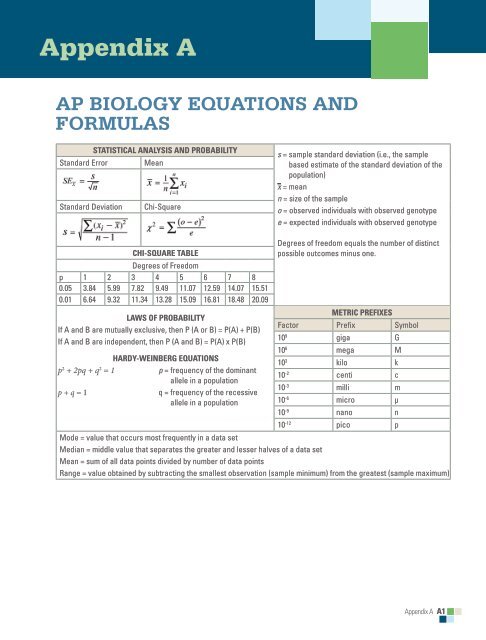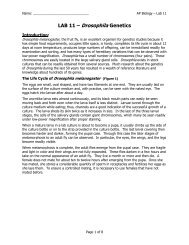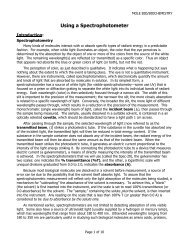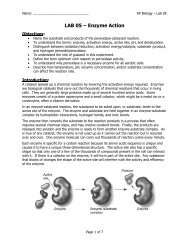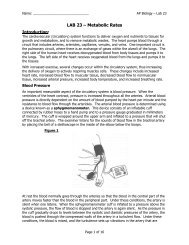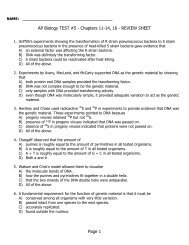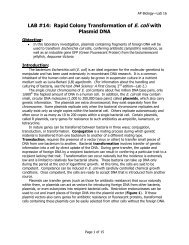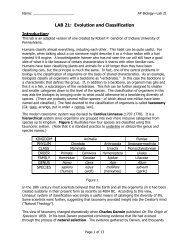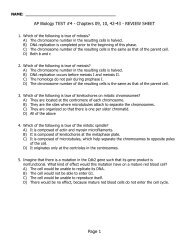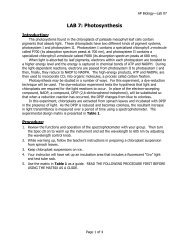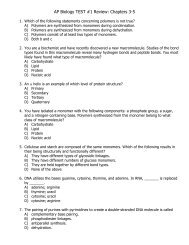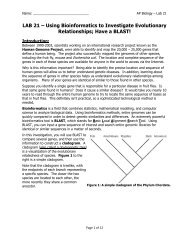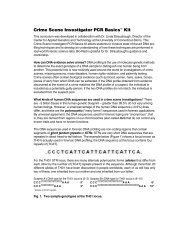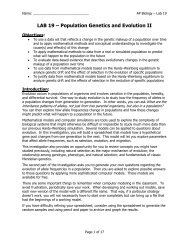AP Biology Equations and Formulas - College Board
AP Biology Equations and Formulas - College Board
AP Biology Equations and Formulas - College Board
Create successful ePaper yourself
Turn your PDF publications into a flip-book with our unique Google optimized e-Paper software.
Appendix A<br />
<strong>AP</strong> BIOLOGY EQUATIONS AND<br />
FORMULAS<br />
Statistical Analysis <strong>and</strong> Probability<br />
St<strong>and</strong>ard Error<br />
Mean<br />
St<strong>and</strong>ard Deviation Chi-Square<br />
s = sample st<strong>and</strong>ard deviation (i.e., the sample<br />
based estimate of the st<strong>and</strong>ard deviation of the<br />
population)<br />
x = mean<br />
n = size of the sample<br />
o = observed individuals with observed genotype<br />
e = expected individuals with observed genotype<br />
Chi-Square Table<br />
Degrees of Freedom<br />
p 1 2 3 4 5 6 7 8<br />
0.05 3.84 5.99 7.82 9.49 11.07 12.59 14.07 15.51<br />
0.01 6.64 9.32 11.34 13.28 15.09 16.81 18.48 20.09<br />
Laws of Probability<br />
If A <strong>and</strong> B are mutually exclusive, then P (A or B) = P(A) + P(B)<br />
If A <strong>and</strong> B are independent, then P (A <strong>and</strong> B) = P(A) x P(B)<br />
Hardy-Weinberg <strong>Equations</strong><br />
p 2 + 2pq + q 2 = 1<br />
p = frequency of the dominant<br />
allele in a population<br />
p + q = 1<br />
q = frequency of the recessive<br />
allele in a population<br />
Degrees of freedom equals the number of distinct<br />
possible outcomes minus one.<br />
Metric Prefixes<br />
Factor Prefix Symbol<br />
10 9 giga G<br />
10 6 mega M<br />
10 3 kilo k<br />
10 -2 centi c<br />
10 -3 milli m<br />
10 -6 micro μ<br />
10 -9 nano n<br />
10 -12 pico p<br />
Mode = value that occurs most frequently in a data set<br />
Median = middle value that separates the greater <strong>and</strong> lesser halves of a data set<br />
Mean = sum of all data points divided by number of data points<br />
Range = value obtained by subtracting the smallest observation (sample minimum) from the greatest (sample maximum)<br />
Appendix A A1
Rate<br />
dY/dt<br />
Population Growth<br />
dN/dt=B-D<br />
Exponential Growth<br />
Logistic Growth<br />
Rate <strong>and</strong> Growth<br />
dY= amount of change<br />
t = time<br />
B = birth rate<br />
D = death rate<br />
N = population size<br />
K = carrying capacity<br />
r max<br />
= maximum per capita growth rate<br />
of population<br />
Temperature Coefficient Q 10<br />
t 2<br />
= higher temperature<br />
t 1<br />
= lower temperature<br />
k 2<br />
= metabolic rate at t 2<br />
k 1<br />
= metabolic rate at t 1<br />
Primary Productivity Calculation<br />
Q 10<br />
= the factor by which the reaction<br />
mg O 2<br />
/L x 0.698 = mL O 2<br />
/L<br />
rate increases when the<br />
mL O 2<br />
/L x 0.536 = mg carbon fixed/L temperature is raised by ten<br />
degrees<br />
Surface Area <strong>and</strong> Volume<br />
Volume of a Sphere<br />
V = 4/3 π r 3<br />
Volume of a Cube (or Square Column)<br />
V = l w h<br />
Volume of a Column<br />
V = π r 2 h<br />
Surface Area of a Sphere<br />
A = 4 π r 2<br />
Surface Area of a Cube<br />
A = 6 a<br />
Surface Area of a Rectangular Solid<br />
A = Σ (surface area of each side)<br />
r = radius<br />
l = length<br />
h = height<br />
w = width<br />
A = surface area<br />
V = volume<br />
Σ = Sum of all<br />
a = surface area of one side of the cube<br />
Water Potential (Ψ)<br />
Ψ = Ψp + Ψs<br />
Ψp = pressure potential<br />
Ψs = solute potential<br />
The water potential will be equal to the<br />
solute potential of a solution in an open<br />
container, since the pressure potential<br />
of the solution in an open container is<br />
zero.<br />
The Solute Potential of the Solution<br />
Ψs = – iCRT<br />
i = ionization constant (For sucrose<br />
this is 1.0 because sucrose does not<br />
ionize in water.)<br />
C = molar concentration<br />
R = pressure constant (R = 0.0831 liter<br />
bars/mole K)<br />
T = temperature in Kelvin (273 + ºC)<br />
Dilution – used to create a dilute<br />
solution from a concentrated stock<br />
solution<br />
C i<br />
V i<br />
= C f<br />
V f<br />
i = initial (starting)<br />
C = concentration of solute<br />
f = final (desired)<br />
V = volume of solution<br />
Gibbs Free Energy<br />
ΔG = ΔH – TΔS<br />
ΔG = change in Gibbs free energy<br />
ΔS = change in entropy<br />
ΔH = change in enthalpy<br />
T= absolute temperature (in Kelvin)<br />
pH = – log [H+]<br />
A2 Appendix A


